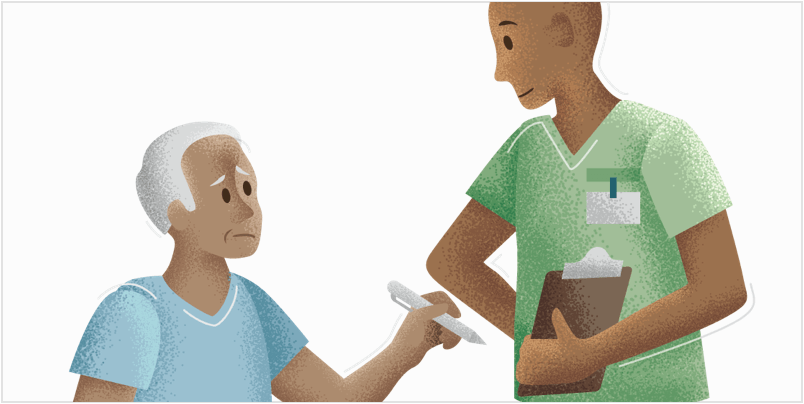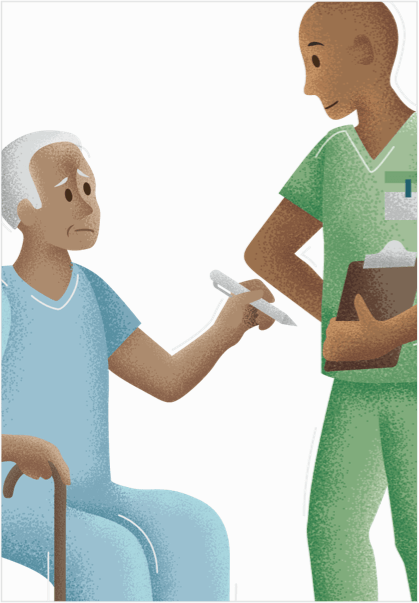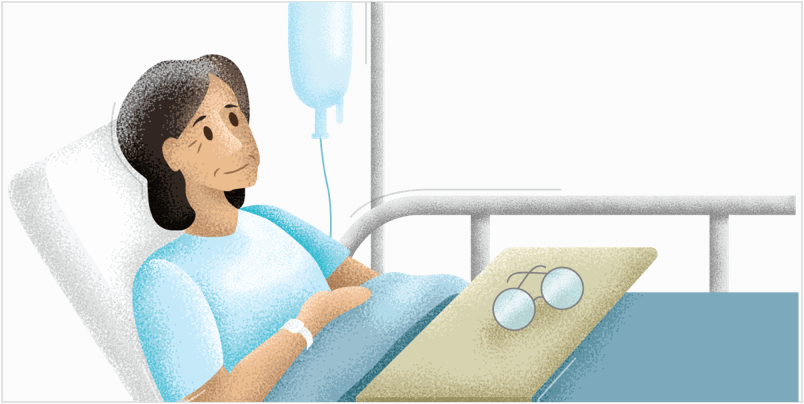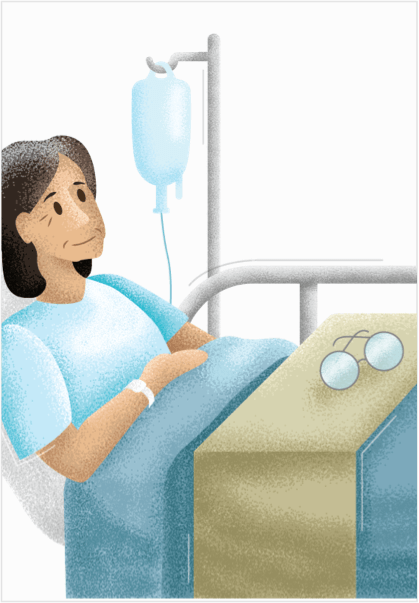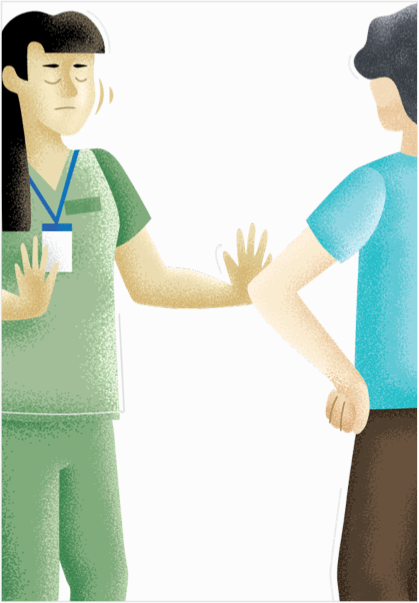Patient Ombudsman is a champion for fairness in Ontario’s healthcare system.
In our second year, we received more complaints and facilitated more resolutions to improve our healthcare system for all Ontarians.
Last year we asked Ontarians to be fearless in bringing their complaints to our office. This year we share how an Ombudsman in healthcare seeks fairness for everyone.
How we work
Patient Ombudsman understands that making a complaint can be confusing and even daunting. It is important for us to share how we work. It is also important for us to help complainants along each step of the way.
Our process
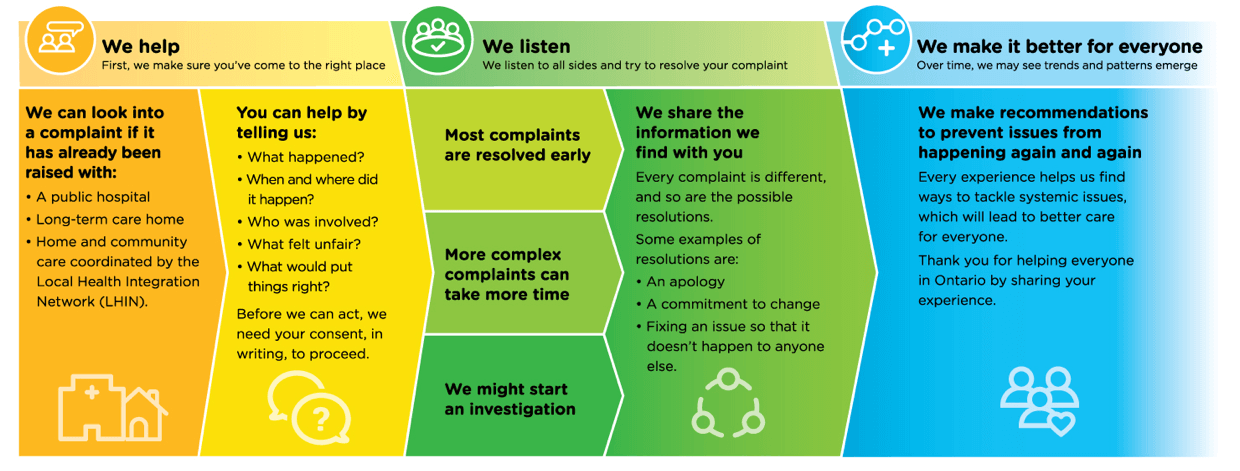
What to expect when you make a complaint
We help – First we make sure you’ve come to the right place
You can help by telling us:
- What happened?
- When and where did it happen?
- Who was involved?
- What felt unfair?
- What would put things right?
We cannot help if your complaint is:
- Premature (you must first raise it with your health sector organization)
- About a regulated health professional (examples are a doctor or nurse)
- About a private retirement home
- Part of a court proceeding
If we can can’t help, we will refer you to someone who can.
We listen to all sides to try to resolve your complaint
We share the information we find with you.
Some examples of resolutions are:
- An apology
- A commitment to change
- Fixing an issue so that it doesn’t happen to anyone else
We make recommendations to prevent issues from happening again and again
Thank you for helping everyone in Ontario by sharing your experience
What is “fairness?”
In our second year, Patient Ombudsman felt it was important to try to describe how we assess fairness, both to guide our work and to share that information with the public.
Ombudsman Saskatchewan uses a “Fairness Triangle” to describe how it achieves fair resolutions to complaints about government services. Patient Ombudsman has adapted Saskatchewan’s approach to our unique role in resolving and investigating complaints from patients and caregivers about their healthcare experiences. We worked closely with our front-line complaints team and consulted with patient and caregiver advisors, healthcare patient relations specialists and others to develop our version of the Fairness Triangle.
The Fairness Triangle is not a checklist. The Fairness Triangle is a set of principles or considerations that Patient Ombudsman applies in analyzing a complaint and testing if a resolution is fair.
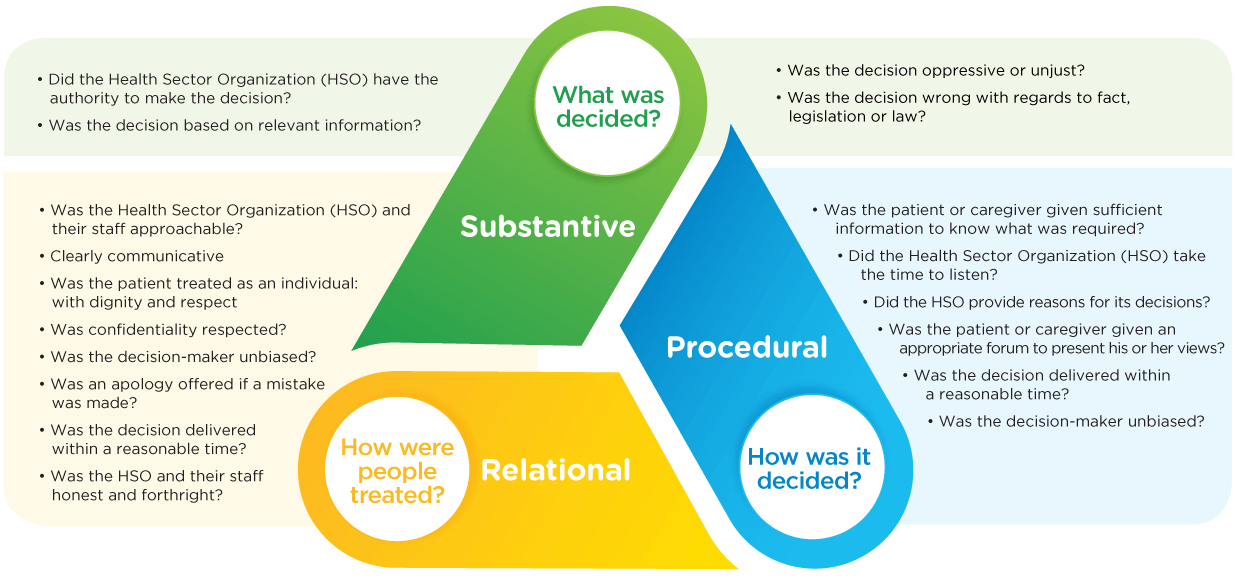
Fairness triangle
Substantive
What was decided?
- Did the Health Sector Organization (HSO) have the authority to make the decision?
- Was the decision based on relevant information?
- Was the decision oppressive or unjust?
- Was the decision wrong with the regards to fact, legislation or law?
Procedural
How was it decided?
- Was the patient or caregiver given sufficient information to know what was required?
- Did the Health Sector Organization take the time to listen?
- Did the Health Sector Organization provide reasons for its decisions?
- Was the patient or caregiver given an appropriate forum to present his or her views?
- Was the decision delivered within a reasonable time?
- Was the decision-maker unbiased?
Relational
How were people treated?
- Was the Health Sector Organization and their staff approachable?
- Was the patient treated as an individual: with dignity and respect?
- Was confidentiality respected?
- Was the decision-maker unbiased?
- Was an apology offered if a mistake was made?
- Was the decision delivered within a reasonable time?
- Was the Health Sector Organization and their staff honest and forthright?
Results in our second year
In our first year, Patient Ombudsman received almost 2,000 complaints from patients and caregivers. The number increased by 16% in our second year growing to over 2,300 complaints, including 710 formal written complaints. This growth continues into our third year. Of the 1,591 complaint enquiries that initially came in by phone or in-person, only 109 were followed up by a formal written complaint. Just over 600 complainants made their first contact with Patient Ombudsman in the form of a written complaint.
Almost half (45%) of complaints came from patients themselves. 49% came from caregivers, including family members, substitute decision-makers and people with powers of attorney for care. Five percent of complaints came from friends or others, including members of provincial parliament and patient advocates, and one percent of complainants did not disclose their relationship to the patient.
1,723 referrals
were made to other organizations or complaint bodies
What did patients and caregivers complain about?
As in our first year, the majority of complaints related to patient and caregiver experiences with public hospitals. This doesn’t mean that Ontarians are more unhappy about hospital-based care than other services. More people have interactions with hospitals than with long-term care homes or LHIN home and community care. For the latter two services, there are other ways to escalate complaints beyond the health service organization, including the Ministry of Health and Long-Term Care’s Action Line and the Health Services Appeal and Review Board.
Top 10 complaints by sector*
1,346 complaints about public hospitals
- 27% Assessment/
diagnosis/ treatment - 17% Discharge/
transfer/ transitions - 14% Communication/
engagement - 13% Quality of care
- 12% Complaint process
- 9% Access or admission
- 9% Sensitivity/
caring/ respect - 7% Finance/
cost - 7% Access to patient records
- 7% Delay
233 complaints about LHIN home and community care
- 25% Access or admission**
- 25% Coordination/
continuity - 21% Staffing/
resources/ services - 19% Discharge/
transfer/ transitions - 16% Communication/
engagement - 11% Quality of care
- 8% Operational/
procedural issues - 8% Sensitivity/
caring/ respect - 8% Staff skills
- 5% Delay
214 complaints about long-term care homes
- 25% Quality of care
- 12% Sensitivity/
caring/ respect - 12% Communication/
engagement - 11% Assessment/
diagnosis/ treatment - 10% Alleged abuse
- 10% Complaint process
- 10% Visitation/
no trespass - 9% Discharge/
transfer/ transitions - 7% Personal security/safety
- 5% Finance/
cost
* Percentages are based on the frequency a complaint type occurred in relation to the total number of complaints, totals will equal more than 100%. **including level of service
The subject of complaints varies across healthcare settings. The most frequent complaints about hospitals were about clinical care, discharge or transfer arrangements, and communication/patient engagement. While the standard of clinical care is primarily within the realm of the health professional colleges, hospital policies and staffing levels were often contributing factors in patient complaints.
How were complaints resolved?
The greater part of Patient Ombudsman’s work is focused on achieving an early resolution to complaints. Every complaint is different and many are complex with a mix of elements that are within Patient Ombudsman’s jurisdiction and other elements that fall under the authority of other bodies. Patient Ombudsman provided over 1,600 patients and caregivers with navigation assistance resulting in a total of 2,341 referrals. More than 600 people were reconnected with patient relations at their health service organization to continue to work on a resolution at the point of care. 90 complaints were withdrawn after this connection was made. Almost 750 patients and caregivers were referred to regulatory colleges, most frequently the College of Physicians and Surgeons of Ontario. Mandatory reports were made to the Ministry of Health and Long-Term Care in 29 cases in relation to allegations of abuse in long-term care homes.
Complaints about us
Our business is complaints, and we believe it is important to walk the talk. We welcome feedback from patients, caregivers and health sector organizations about our services. Complaints give us important information about how we can improve the services we provide. In our second year, we received 14 complaints from patients and caregivers who were dissatisfied with their experience with our office.
Monitoring complaint trends and clusters
Patient and caregiver complaints about their experience with healthcare provide important information about opportunities to improve care. Patient Ombudsman is committed to sharing information about the trends we observe to help to inform quality improvement efforts by health sector organizations. This year, we are spotlighting five issues based on clusters of similar complaints we received from multiple patients and caregivers.
Spotlight issues:
Final thoughts & reflections
Patient Ombudsman looks forward to continuing our work throughout our third year and beyond. We will continue to monitor and track the trends we see in complaints and share these issues with stakeholders in our healthcare system to both improve the quality of healthcare experiences for Ontarians and to ensure that these same concerns do not keep happening to patients and families.
Patient Ombudsman will continue to shine a light on new and emerging concerns we see and work with complainants and health sector organizations towards resolutions that are meaningful and fair.
Some complaints require a more rigorous approach and that is why we are refining our investigative tools and involving our investigators in cases that are complex and may require more resources.
Patient Ombudsman views our work as a service to all Ontarians. Because of this Patient Ombudsman is in the pursuit of constantly improving that service. Sharing more about how we work with tools like the Fairness Triangle and developing a Service Charter for complainants and health sector organizations will not only make our work more accessible but solidify a process that is fair for everyone.













